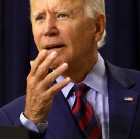Conservative Roots
The Roaring Conservative ?20s: Harding, Coolidge, and Hoover
The 1920s were a high point for conservatism, both electorally and politically? and then the stock market crashed
Listen to this story
–:–
–:–
Ask any number of conservative leaders when was the greatest period of conservatism in the United States, and they?ll typically give you one of two answers ? depending on who you?re asking.
The talk radio crowd will tell you it was the Reagan ?80s, giving you a handful of quotes and speeches from the Great Communicator, while assuring you how much greater and more patriotic America was in those days. Ask the writers and thinkers of the movement, and many will point to the Roaring ?20s, using the period more as an example of successful small government economic policy than the sainthood of one individual.
The 1920s was a period that saw three presidents elected to office ? all Republicans, all elected by massive landslides, all perceived as business-friendly, and all controversial and usually maligned by historians. All three saw incredibly different perceptions of their presidencies play out for their contemporaries.
The first, Warren G. Harding, oversaw an impressive economic recovery and began to make the necessary steps that would allow his successor to push through a pro?free market agenda. All of that was overshadowed, however, by personal failings and scandals during Harding?s time in the Oval Office.
The second, Calvin Coolidge, oversaw a booming economy and a surging stock market while enjoying incredible popularity. He pushed through what may be argued to be the most business-friendly policies in the country?s history and cut spending and taxes to levels conservatives can only dream about today.
The final president of the era, Herbert Hoover, oversaw an economic recession that would become a depression after the infamous stock market crash and was booted from office in a landslide election.
This is the story about how conservatism saw an incredible high with the first two presidents, and how it was cast into the wilderness in the aftermath of the third.
![]()
Keep in mind just how exciting and turbulent the 1920s were. Prohibition, the law that banned alcohol in the United States, was in full effect throughout the decade. Of course, smart businesspeople set up speakeasies?illicit nightclubs for those in the know to enjoy illegal booze. Some of those club owners were gangsters who terrorized the streets of major cities like Chicago in turf wars over who could sell these illegal beverages. And these secret clubs showcased a growing genre of music that was booming at the time: jazz.
But the decade wasn?t just about illegal nighttime activities over beverages. During the 1920s, women were given the right to cast a vote. Charles Lindbergh became the first man to fly solo across the Atlantic. A down-on-his-luck animator named Walt Disney created a character he called Mortimer Mouse, later changed to Mickey Mouse after his wife protested. Babe Ruth dominated baseball as he broke home-run records. And the film industry exploded, finally achieving the ability to include sound in movies by the end of the decade.
At the start of the 1920s, the country was in rough shape. The outgoing president, Democrat Woodrow Wilson, suffered a debilitating massive stroke that cast him to a darkened corner in the White House, only seen by those who dared try to meet with the ill president.
Wilson was an unpopular figure at that time, the last leader of the country?s decades-long Progressive Era, which saw folks like Wilson, and even a Republican like Theodore Roosevelt, pass massive reforms that were not so business-friendly but stressed helping the union worker and those in the lower class of the wealth spectrum. By the time Wilson was about to leave office, progressivism ? a force for electoral victory and political popularity for so many years ? had become a damaged brand to avoid.
The economy tanked, causing a now-forgotten depression that some estimates say drove an unemployment rate of almost 14 percent. The country?s finances were a mess, ballooning to around $25 billion in debt and running on a deficit. Labor strikes shut down industries. The KKK marched in the streets as race riots broke out in major cities. The year 1920 was not a time to be running on continued reforms and changes.
With the country tired after the decades of the Progressive Era, it was only smart for Republican candidate Warren G. Harding to run on a ?return to normalcy? that year. Harding, a senator from Ohio, was the GOP?s pick after the convention in Chicago had become deadlocked on two candidates. To calm the anger of some who felt Harding was a compromise chosen by the party establishment, the party chose Massachusetts Governor Calvin Coolidge as his running mate.
Beating up on the unpopular Wilson, hammering home the promise to return to normalcy, and with the country ready for change, Harding defeated Democratic nominee James Cox (whose running mate happened to be Franklin D. Roosevelt) to become president in a massive landslide.
![]()
Now, Harding wasn?t exactly the most moral, upstanding citizen. When he was being vetted for the nomination, Harding was asked if he had any skeletons in his closet. As presidential historian Richard Norton Smith once said of the man: His skeletons had skeletons. Harding was a known womanizer and was accused of potentially fathering children with various mistresses. He was also known to pay no attention to Prohibition rules and had bootleggers keep the White House well stocked. Harding even gambled away the White House china.
These indiscretions extended to his administration. Harding?s cabinet played fast and loose with the law, and scandals grew out of this. The biggest among them, of course, being Teapot Dome, a bribery scandal involving various members of the administration. The scandals plagued Harding, who at one point is said to have rebuked members so harshly that he allegedly choked one of them in his frustration over how the White House was being so frequently scandalized. This earned Harding a rough spot in the presidential rankings, being regularly seen as one of the worst of the commanders in chief.
Harding?s contributions to conservatism, however, seem to have gone unnoticed. First and foremost: his hires. Harding appointed Charles Evans Hughes back to relevance in Washington, D.C., where he would eventually become Supreme Court chief justice and a foil to many New Deal programs in the progressive 1930s. Harding appointed Andrew Mellon, a strong proponent of capitalism and free markets, as treasurer and created a new position of budget director for Charles G. Dawes. Also among Harding?s conservative successes were slashing taxes and attacking the debt, as well as brokering the 1922 Washington Naval Treaty between the United States, Britain, and Japan, preventing a potentially dangerous naval arms race for more than a decade.
Harding?s restless period of scandals ended abruptly in 1923, when he suddenly died from a heart attack during a cross-country trip. News reached Vice President Coolidge, who was visiting his father at their family home in Vermont, in the middle of the night. His father, a notary, administered the oath of office. Now president, Coolidge calmly went back to sleep.
![]()
Unlike Harding, Coolidge was a man with outstanding moral character. He remained faithful to his wife. He did not spend nights gambling things away or enjoying illegal drinks; in fact, he had little use for alcohol. The man was so reserved that he was nicknamed ?Silent Cal.?
Born on July 4, Coolidge was known for playing to the camera and wearing a costume or two while out traveling the country. He also used the radio to great effect, long before FDR?s ?fireside chats.? Coolidge?s wife had a pet raccoon, and he was once gifted baby lion cubs during his presidency. One of their dogs is featured in the first lady?s official portrait.
Coolidge may have inherited a White House filled with scandals and distrust, but he also inherited a far better economy and fiscal situation than his predecessor had. The unemployment rate had dropped dramatically from the 1920 depression high of almost 12 percent to estimates as low as 3 percent. The nation?s debt had dropped from $25 billion to $22 billion. The deficit was gone, replaced by a surplus. This was all achieved through an aggressive laissez-faire policy that conservatives today would applaud. And yet it was not enough for Coolidge.
Coolidge cut taxes and spending even lower and was aggressively more conservative in his approach to economic and fiscal policy than even Harding had been. Once, he rejected a bill to aid farmers, a group he was very familiar with given his roots in Plymouth Notch, Vermont, because he didn?t see a reason for the government to get involved even as the farmers faced tough times. Coolidge even had a funny habit of not having a seat for Oval Office visitors to sit in because he thought it would give the visitor less time to ask for things from him or the government. As columnist and Coolidge biographer Amity Shlaes has said, he was the ?Great Refrainer.?
Coolidge?s idea of conservative economic policies were a bit different than today?s supply-siders. Reagan admired Coolidge and believed in his ideals of smaller government, and his tax policies showed that. However, Coolidge?s spending habits were more aggressively hawkish fiscally than those of Reagan or George W. Bush. Cutting taxes wasn?t enough for Coolidge; he believed that cutting spending alongside tax cuts was equally important. Today?s conservatives seem to have a battle with this logic. Lower taxes are all the rage, but whether politicians are willing to make cuts, especially with modern conservatism?s hawkish views on defense, is another story.
There was, however, one fly in the ointment: protectionism. The GOP of that time considered high tariffs to be necessary for the prosperity of the American worker, while the Democrats, then based in more rural and agricultural areas, tended to support free trade and lower consumer prices. This policy aggravated the already delicate economic situation in a world still reeling from World War I, and, as we will see below, this instinct would become worse under Hoover.
Coolidge lived in a time when conservatism was much more inviting for minorities and more appealing to urban demographics. He was elected in 1924 running under a Republican platform that pushed against lynching. The KKK suffered significant influence losses under Coolidge. He signed a law that gave Native Americans rights to citizenship. He even won New York City during his 1924 landslide, a feat no Republican has accomplished since.
However, Coolidge also signed a controversial immigration-restriction act into law in 1924. Coolidge himself was said to be hesitant in supporting it, and even many of his modern-day fans have criticized this move. But given how today?s conservatism is divided on how to handle immigration, it?s no surprise that immigration hawks on the right have consistently pointed to this as an ?achievement? by Coolidge.
Coolidge?s differences with modern-day conservatism also apply to defense. Unlike today, a focus on increasing defense spending wasn?t a big part of 1920s conservatism. And while Coolidge was not an isolationist, he considered the 1920 electoral results as a rejection of getting too involved in world affairs given Wilson?s failures with the League of Nations. While he brokered a deal, known at the Dawes Plan, to make it easier for America?s former allies to pay their heavy war debts to the United States, neither he nor anyone else considered allowing the debt to lapse to help Europe recover faster. However, Coolidge did support becoming part of the World Court and refused to recognize the Soviet Union.
By 1928, Coolidge had decided not to run for another term in office. He was leaving a country that in eight years had seen unemployment drop, the debt collapse from $25 billion to $17 billion, the deficit become a sizable surplus, and the stock market reach a then-high point. Coolidge?s economic successes have been a pillar of conservative arguments for their policies.
However, just as conservatism was seemingly hitting a peak point, something would happen that would cast it into the wilderness after a decade of power, and it would not only damage the next president?s historical legacy but also cast a long shadow over Coolidge?s.
![]()
Herbert Hoover was an Iowa native, an orphan by age nine, and a self-made man. He was secretary of commerce and a popular figure when he was chosen as Coolidge?s successor for the GOP nomination in 1928. Coolidge was not Hoover?s biggest fan?once remarking that Hoover did nothing but give him bad advice while he was president?but Coolidge backed his party?s nominee. Hoover?s popularity, the Catholic faith of his Democratic foe, and the split among Democrats on Prohibition helped Coolidge win in a massive landslide, like his two previous predecessors.
Hoover campaigned on continuing Coolidge?s work, but in reality, Hoover was no conservative. In fact, Democrats sought Hoover to run for them in 1920. Yet his ties with the Republican Party and conservatism led to him becoming the face of conservatism?s failures among detractors of the ideology.
The event that would shake conservatism?s dominance in the 1920s was the stock market crash of 1929, followed by a recession that progressively worsened and became the Great Depression. Hoover wasn?t even a year into office when it struck, and it would define his administration?s entire existence and, in turn, his legacy.
Many critics of conservatism have blamed Hoover?s predecessor for the business cycle going bad. But it should be noted that Coolidge thought the cycle was due for a rough time, and he was never comfortable with how high the stock market was rising. Conservative proponents would argue that not much could have stopped the coming downturn; however, how that downturn was handled is a different matter for debate.
It should also be noted that the Great Depression was a global phenomenon and had global causes; it was not solely the result of Wall Street chicanery or a bad business cycle. Responsible first and foremost was the massive economic fallout of World War I (Europe was a major economic outlet for America and a massive borrower of loans), with its enormous loss of physical and financial wealth, as well as the huge debts everyone owed each other in treaties and contracts. Another factor was the controversial attempt to peg currency to a gold exchange standard. As an aside, it should also be noted that not all countries responded to the crash with New Deal?style policies; Britain, for instance, enacted fiscally conservative policies and got off regularly lightly, as did Scandinavia.
As the economy tanked (along with his popularity), Hoover desperately sought out less-than-conservative policies. He expanded public works. He signed into law the then-highest peacetime tax increase in the country?s history. He even (reluctantly) signed a tariff that would end up hurting foreign trade. This tariff helped spark a trade war between countries around the world, further aggravating world relations and the global economic situation; a major blind spot in GOP economic thinking at the time was in failing to understand why global economic health was as important for America as the domestic situation. Spending went up as well: By the time Hoover?s time in office was up, the nation?s debt rose for the first time since Wilson, and the country returned to running on a deficit.
Hoover?s bigger-government approach had no impact on helping the Great Depression subside. By 1932, he was deeply unpopular, the unemployment rate was in the 20s, the debt and deficit situation had gotten worse, and the country was ready for ?normalcy? to take a back seat again. They wanted someone who would save them. This set the stage for Franklin D. Roosevelt?s 1932 landslide win over Hoover.
Conservatism, after a decade of dominance, was now back in the wilderness, not to be seen again on the national stage for decades. It started out with great hope when Harding won, reached its zenith with economic prosperity under Coolidge, and now, as Hoover left office, conservatism was a seemingly mortally damaged brand while progressivism was back in vogue.
![]()
Hoover?s troubles have led him to become one of historians? most maligned presidents, regularly ranking very low. The Great Depression also led to debates on Coolidge?s legacy. The stock market crash was perhaps a sign of not just the impending economic malaise the country would endure for some time, but also that the party was over for conservatism.
As if that wasn?t enough symbolism, Calvin Coolidge passed away following sudden heart problems just a few months before Roosevelt?s inauguration, which would precede a new progressive era known as the New Deal Era. Shortly before his death, Coolidge said to a friend, ?I feel I no longer fit in with these times.? The same could have been said at the time about conservatism.
![]()
- Murphy, Robert P. ?The Depression You?ve Never Heard Of: 1920?1921 | Robert P. Murphy.? (n.d.): n. pag. FEE. Foundation for Economic Education, 18 Nov. 2009. Web. 14 June 2017.
- Shlaes, Amity; Cole, Ryan. ?Reassessing Warren G. Harding.? National Review. N.p., 04 Mar. 2011. Web. 14 June 2017.
- Shlaes, Amity. Coolidge. New York, NY: Harper Perennial, 2014. Print.
- http://federal-budget.insidegov.com/
186
- Politics
- History
- Conservation
- Stock Market
- Economics
186claps
186claps

Did An African American Invent The Light Bulb?
Grant Piper in Exploring History
Where Do You Start If You Want To Meditate With Psychedelics?
The Third Wave
All of Our Pretty Universes
Jerry Toth
The Gila River: The Southwest?s Threatened Eden
Defenders of Wildlife in Wild Without End
Republicans vs. Imaginary Biden
Nicholas Grossman in Arc Digital
The American Forerunner of Jack the Ripper
Michele Caimmi in History of Yesterday
Microdosing Mushrooms Journal, Take 3: Unpopular Opinion
The Clumsy Gypsy in Samadhi.today


